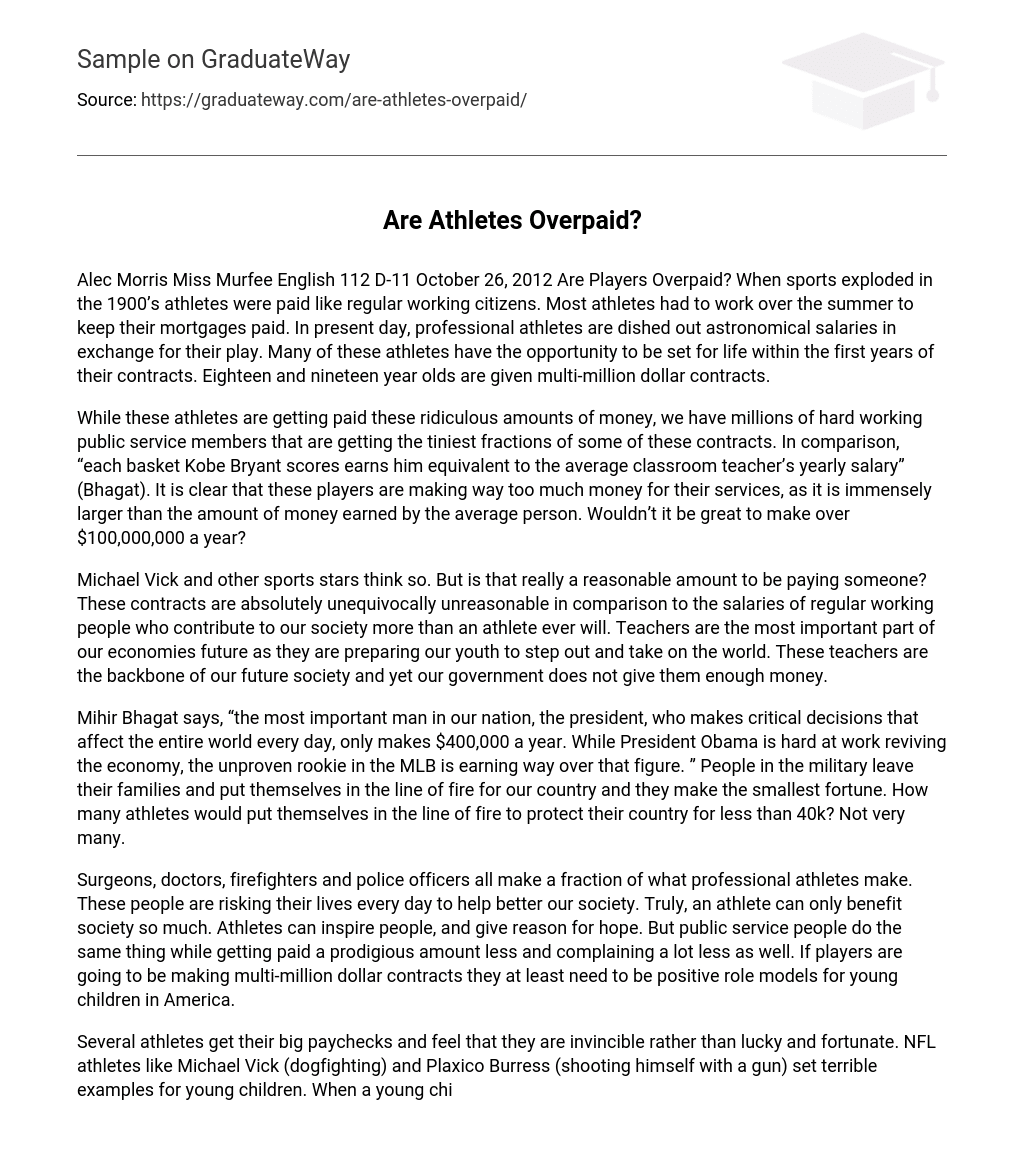In the 1900s, sports players received salaries similar to ordinary workers and often worked during the summer to pay their mortgages. However, today professional athletes earn extravagant salaries for their performance. Many of these athletes can secure their financial future in the early years of their contracts. It is common for eighteen and nineteen year olds to be offered multi-million dollar deals.
While dedicated public service workers receive low salaries, athletes are earning extravagant paychecks. A single basket made by Kobe Bryant, for instance, earns him as much as the annual salary of an average classroom teacher. This comparison highlights the excessive compensation received by players that far surpasses that of ordinary individuals. The notion of earning over $100 million annually is undeniably tempting.
While Michael Vick and other sports stars consider paying someone $100 million to be fair, these agreements seem unfair when compared to the salaries of everyday people who contribute more to society than athletes do. Teachers have a vital role in shaping our economy’s future by preparing the youth for success, serving as the foundation of our future society. Unfortunately, our government does not allocate enough funding for them.
Mihir Bhagat points out the disparity in salaries between the president, who wields substantial power and has a daily impact on global affairs, earning just $400,000 per year. In contrast, even an inexperienced rookie in Major League Baseball (MLB) earns considerably more. Additionally, those serving in the military make significant sacrifices by leaving their families and facing danger for their country, yet they receive relatively modest wages. Bhagat questions how many athletes would be willing to risk their lives to defend their nation for a salary of less than $40,000; suggesting that the answer would likely be very few.
While surgeons, doctors, firefighters, and police officers put their lives at risk daily to better society, they receive only a fraction of the income that professional athletes do. Even though athletes can provide inspiration and hope, public service workers fulfill the same function while earning considerably less and complaining much less. If players are going to be rewarded with multi-million dollar contracts, it is crucial for them to serve as positive role models for young American children.
Some athletes, upon receiving their large salaries, develop a sense of invincibility rather than acknowledging their luck and good fortune. Instances include NFL players such as Michael Vick, who was involved in dogfighting, and Plaxico Burress, who accidentally shot himself with a gun. These individuals serve as negative examples for young children. When a child admires an athlete only to see them getting arrested, the child may wrongly assume that they too can break the law without consequences because they might still receive a lucrative contract. Despite positive role models like Drew Brees (the quarterback for the New Orleans Saints) and Ray Lewis (the linebacker for the Baltimore Ravens) existing in professional sports, should all athletes strive to be good role models?
There is a widespread belief in Europe that athletes are receiving excessive payment, even when comparing different countries. The recent contract between Zlatan Ibrahimovic, a Swedish soccer player, and Paris Saint-Germain has caused anger among citizens and politicians in France. This deal is valued at 14 Million Euros per year, which has intensified disapproval given the country’s economic difficulties and increasing unemployment rates. In fact, one politician expressed strong displeasure by stating, “These wages make me indignant and almost disgust me” (McPartland).
France’s 75% tax bracket on the highest salaries leads to PSG paying Ibrahimovic 14 Million Euros, plus an additional 21 Million Euros to the government. While this may appear absurd, it does contribute to governmental funds. In 2009, the Washington Redskins signed NFL defensive tackle Albert Haynesworth for a seven-year contract worth over $100,000,000. To make room for this significant signing, Alexander Knight reveals that the Redskins front office had to let go of 23 employees.
The text highlights the egocentricity of certain professional teams by showcasing their tendency to prioritize one individual over twenty-three solely based on exceptional athletic ability. An example is Albert Haynesworth, who was ultimately released from his team after failing the physical fitness test multiple times, which demonstrated his inadequacy. The National Hockey League has set its minimum salary at $500,000, surpassing the NBA’s minimum of $450,000 and the MLB’s minimum of $400,000. As a result, even newcomers in these leagues earn an equivalent or potentially higher amount than the President of the United States.
Now the President not only has the power to shape the future of our nation but also holds the potential to impact global affairs. How is it possible that an 18-year-old novice pitcher, lacking any professional experience, could earn a higher base salary than the President? Compensation should be commensurate with the value an individual brings to society. However, this principle does not apply when it comes to professional athletes. It is evident that their salaries do not reflect their true worth to society. Otherwise, the President would earn considerably more while athletes would receive considerably less.
Works Cited
-
Bhagat, Mihir. “Oakland Raiders. ” Bleacher Report. N. p. , 21 Mar. 2010. Web. 19 Oct. 2012.
.
- Carew, Chrissy, and Won M. Kim. “Are Pro Athletes Paid Too Much? ” Are Pro Athletes Paid Too Much? 19 Sept. 2011: n. pag. EBSCO. Web. 18 Oct. 2012.
-
Knight, Alexander. “Athletes Make Too Much Money. ” The Gramblinite. N. . , 19 Mar. 2009. Web. 19 Oct. 2012.
.
-
McPartland, Ben. “Ibrahimovic’s PSG Salary ‘disgusts’ French Politicians. ” FRANCE 24. N. p. , 19 July 2012. Web. 19 Oct. 2012.





